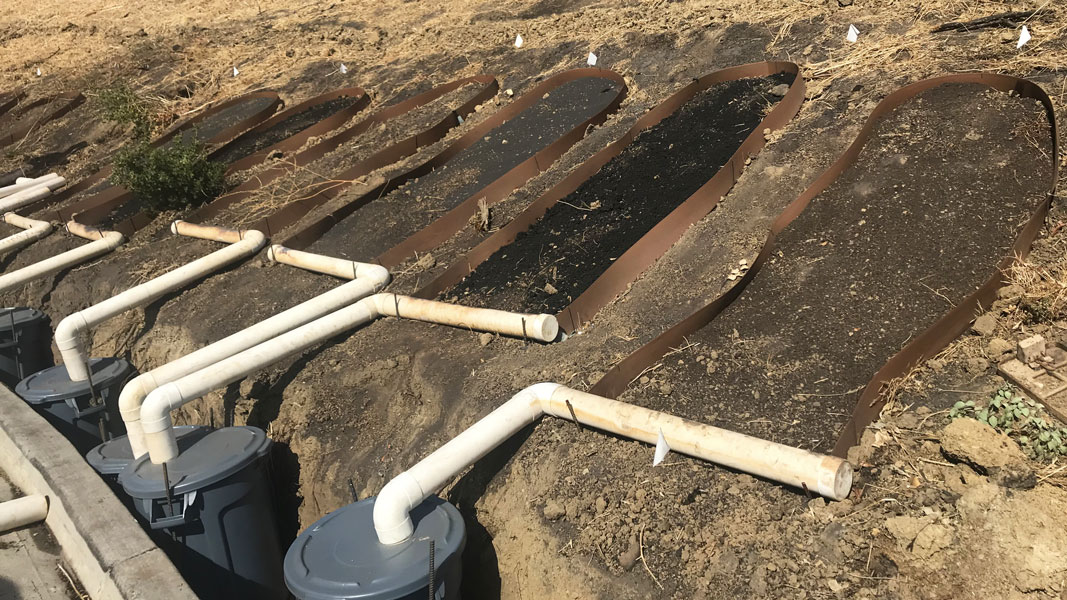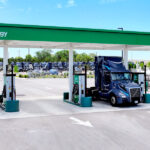Top: The Las Virgenes Municipal Water District (LVMWD) composting facility in Calabasas was impacted by the Woolsey Fire, which left significant burn scars on the property. This provided an ideal site to conduct the research. Photos courtesy Harry Allen
The Woolsey Fire in southern California in November 2018 affected vegetated slopes in the City of Calabasas and in neighboring communities in Los Angeles and Ventura Counties. Vegetation, mostly coastal sage scrub, was completely burned off. Subsequent recovery during the following rainy season was spotty. “Land reclamation with biosolids can encourage more consistent vegetative growth, reduce runoff, and restore soil health,” explain the authors of “An assessment of runoff from fire damaged lands amended with biosolids,” a group paper released in 2024. “Such practices could improve water quality and limit pollution exports.”
The Las Virgenes Municipal Water District (LVMWD) composting facility in Calabasas was impacted by the Woolsey Fire, which left significant burn scars on the property. The engineered slopes and easy access at the facility were ideal for experimental conditions. It also was a natural choice because biosolids are composted there. “We compared effects of a single application of three types of biosolids: Class A compost, Class B anaerobically digested cake, and Class A heat dried pellets, and compared these to an untreated negative control,” explains the paper. “Treatment plots were arranged as three replicates of each treatment in a randomized block type configuration.” The study objective was to determine if biosolids addition increases plant establishment and leads to a reduction in runoff and pollution exports.
A single application of biosolids by type was completed in September 2019 (excepting the three control plots). The biosolids were surface applied in a layer <7.5 cm deep (about 3 inches). The plots were not seeded. Runoff was collected immediately after rain events (during winter-spring months) over two years between 2019 and 2021 for chemical and physical constituents (water quality parameters). Chemical analysis included Total Suspended Solids, Volatile Suspended Solids, Nitrate as N, Total P, Ammonia-N, Organic-N, Cyanide, heavy metals, and select organic contaminants. Runoff volume data also was collected.

The biosolids treatments were applied in September 2019 (from right to left are Class A compost, Class B biosolids, Class A heat-dried pellets and control). In January 2020, the Class A compost and Class B cake sets revegetated rapidly. The Class A pellets set had noticeably less growth.
Composite soil samples were collected from the entire study area plots at a depth of 0-10 cm (0-4 inches) below the surface at the beginning of the project. In January 2023, composite soil samples were collected from control and amended plots for qualitative comparison between the initial and post-treatment soil condition. No detectable concentrations of pesticides, PCBs, or semi-volatile compounds were found in the initial soil or biosolids samples or post-treatment soil samples. Ammonia as N, Total Kjeldahl N, copper, zinc, and Total Organic C were greater in the biosolids samples than in unamended soil (control). Total Phosphate was greater in Class A compost and Class B cake. Organic N was greater in Class B and Class A heat-dried pellets.
Both Class A compost and Class B cake encouraged rapid revegetation in experimental plots as compared to Class A pellets and control plots based on visual observation. “The study provides needed science on what compounds are important in surface water monitoring after burn scars and what mass export concentrations a practitioner may anticipate,” conclude the authors. “Our results demonstrate that land application of Class A compost and Class B cake does not increase pollutant mass export compared to unamended soils. Class A heat-dried pellets had highly variable results. Presumably, this was simply due to the observation that they would roll off the plots directly into the water catchment.”
Authors of the paper are Harry Allen, U.S. EPA; David Crohn, Univ. of California Riverside (retired); Veronia Hurtado, Las Virgenes Municipal Water District; Susan Chang, Los Angeles City Bureau of Sanitation; Matthew Hutton, Los Angeles County Sanitation District; and Greg Kester, California Association of Sanitation Agencies. “An assessment of runoff from fire damaged lands amended with biosolids” can be downloaded at this link.













